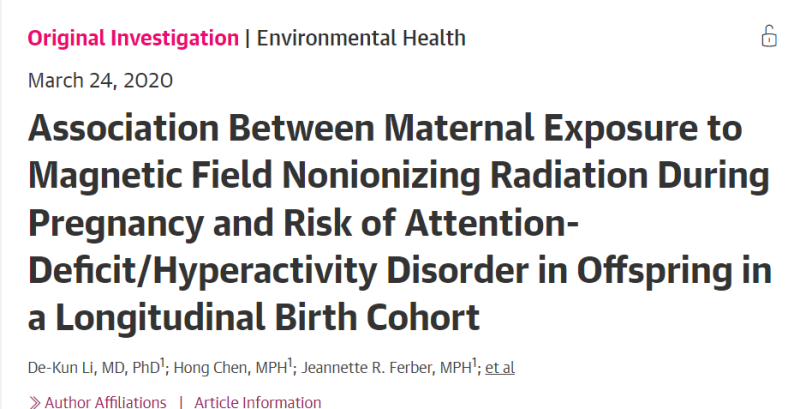
The babies exposed to non-ionizing radiation from electromagnetic fields relatively home strong during gestion are more likely to develop attention deficit hyperactivity disorder (ADHD), according to a birth cohort study.
Specifically, children whose mothers were exposed during pregnancy to fields of more than 1.3 miligauss (mG) during normal activities they were more than twice as likely to develop ADHD as those exposed to lower levels, as explained De-Kun Li, from Kaiser Permanente Northern California in Oakland, and his team.
| Babies exposed in the womb were at increased risk of developing ADHD with immune-related comorbidities |
High exposure was associated with an increased risk of ADHD that persisted until children were 12 years of age or older, as reported by the team in JAMA Network Open. In addition, Li and her peers also noted that babies exposed in the womb had an increased risk of developing ADHD with comorbidities related to the immune system, how asthma or atopic dermatitis.
In an email to MedPage Today, Li noted that “the general finding that high maternal exposure to electromagnetic fields during pregnancy is associated with an increased risk of ADHD in offspring, especially to a more serious degree, and that persisted in adolescence“, It is significant.
But he added that the ADHD subanalysis with comorbidities related to the immune system was especially important, since exposure to magnetic fields is known to affect the immune system. “The most notable finding is that this association is largely present among a subset of ADHD that it has an etiology related to the immune system, “he assured.
During pregnancy, a crucial moment for a baby’s brain development, the fetus is susceptible to environmental risks that can affect neurological behaviorslong term. Magnetic fields, a non-chemical risk factor for ADHD that is emitted from household appliances, power lines, and wireless devices and networks, is a risk yet to be examined, has added the equipment.
Researchers followed children for 20 years
The researchers analyzed exposure to electromagnetic fields in a cohort made up of participants from two previous studies with the same methodology, which took place between 1996 and 1998, and between 2006 and 2012.
The researchers measured the exposure by asking pregnant women to use a 24-hour monitoring meter during their first or second trimester. In addition, in-person interviews were conducted to assess ADHD risk factors and possible confounding factors. High exposure to electromagnetic fields was defined as 1.3 mG or more, and pregnant women were separated into two categories: high exposure and low.
The Yale study published on March 15, 2012, indicates that exposure to radiation from cell phones during pregnancy may affect the brain development of offspring, potentially leading to behavioral disorders such as hyperactivity. The research, conducted by the Yale School of Medicine and led by Dr. Hugh S. Taylor, involved exposing pregnant mice to radiation from cell phones. The results showed that the mice exposed to radiation displayed hyperactive behavior and had reduced memory capacity as adults.
The researchers found that the behavioral changes were due to effects on the development of neurons in the prefrontal cortex of the brain, an area associated with attention deficit hyperactivity disorder (ADHD) in humans. Although the study was conducted on mice, the findings raise concerns about the potential risks of cell phone radiation exposure during human pregnancy.
Dr. Taylor emphasized that further research is needed to understand the mechanisms behind these findings in humans and to establish safe exposure limits during pregnancy. He suggested that limiting fetal exposure to cell phone radiation might be a prudent precaution until more is known.
The study highlights the need for continued investigation into the non-thermal effects of cell phone radiation on developing brains and the importance of considering environmental factors that could impact fetal development.
For more details, you can refer to the original study and additional summaries available on Yale News and ScienceDaily (Yale School of Medicine) (YaleNews) (ScienceDaily) (New Atlas) (Electrosmog Prevention).
| The researchers followed the children from 1997 to 2017 |
The children were followed from May 1997 to December 2017, until they turned 20. Children were considered to have ADHD if they had two or more diagnoses of the disorder at least one year apart.
The researchers also adjusted the possible confounding factors that could be risk factors for ADHD, such as maternal age and ethnicity; the educational level; prenatal smoking and alcohol consumption; body mass index before pregnancy; offspring sex; and sociodemographic characteristics.
According to the researchers, the limitations of the study included possible imprecise reports on maternal exposure to non-ionizing radiation from electromagnetic fields and since the team was unable to ask women to use monitoring devices throughout the pregnancy, the calculation was made using a 24 hour measurement..